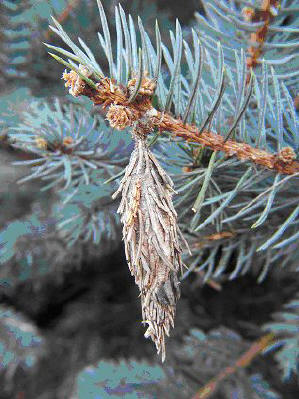Steve Allgeier
Carroll County Master Gardener Program
This has been a great year for bugs in and around the home, and many specimens have crossed my desk in the past month. The big complaint from many
people has been Japanese beetles. They have been found all over the county and reports of heavy damage to roses and a number of other ornamental plants has been attributed to
this pest. Hand picking or use of a labeled pesticide will help in controlling these voracious chewing beetles. Because of the high populations now, there should be plenty of
grass root chewing grubs coming this fall. The end of July will be a good time to apply systemic grub control products for your lawn.
This also seems to be the year of the caterpillar. Plenty of chewed leaves are a good indicator of caterpillar problems. Mimosa webworms in honey
locust trees have been particularly troublesome for many in the Carroll area. Fortunately, the webworm can be treated with Bacillus thuringiensis kurstaki (Dipel, Thuricide),
this spray is extremely safe and effective for young caterpillars. However if the webbing is thick, a high pressure of spray will be needed to penetrate the webbing.
 Bagworms are also a plenty, especially on evergreens, such as Leyland Cypress, Juniper
and Spruce species. This is no surprise considering the large populations that struck the area last year. So if you had some last year and did not treat for them, then you
can pretty much count on having more this year. At this point it would be best not to concentrate on removing the old bags, but to treat infested trees and shrubs with a
registered pesticide.
Bagworms are also a plenty, especially on evergreens, such as Leyland Cypress, Juniper
and Spruce species. This is no surprise considering the large populations that struck the area last year. So if you had some last year and did not treat for them, then you
can pretty much count on having more this year. At this point it would be best not to concentrate on removing the old bags, but to treat infested trees and shrubs with a
registered pesticide.
The past two wet years have increased the incidence of disease in plants. Needlecast disease has become prevalent in many Douglas Fir throughout the
area. Yellowing or brownish - red, older, dead needles is a good indicator of Rabdocline . This foliar disease tends to give the trees a thin almost transparent look as the
inner needles drop off prematurely. The use of a registered fungicide should help to alleviate the problem. Many Black Eyed - Susans are also suffering from leaf spot disease
which will make the plant look ugly, but should have little impact on the overall health of the plant. Prompt removal of infected leaves will help to reduce the problem. If
the Black Eyed Susan is in a wet spot, then you may want to consider moving it to an area with better drainage.
Read other articles about controlling insects & garden pests